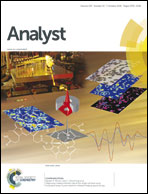A multi-scale approach of the mechanisms underlying exopolysaccharide auto-organization in the Proteus mirabilis extracellular matrix†
Abstract
For decades, the origin of the concentric ring pattern of bacterial swarming colonies has puzzled microbiologists. It was hypothesized that a periodic water activity variation originates a phase transition within the extracellular matrix water H bond network, which switches on and off the exopolysaccharide auto-organization. Both rheological and infrared spectroscopy measurements respectively performed at a molecular scale and on a currently migrating colony, have given a physical insight into the mechanisms which underlie the switch between swarming and consolidation phases. Thanks to in situ and real time infrared microspectroscopy, and thanks to the brilliance of the infrared beam at SOLEIL synchrotron, here we demonstrate that Proteus mirabilis swarming is triggered by a periodic variation of water activity at the colony edge. A dynamic behavior emerges from the global properties of the multicellular entity which relies on the ability of the bacterial cells to tune exoproduct synthesis in order to undergo sharp transitions at a given water activity threshold.


 Please wait while we load your content...
Please wait while we load your content...